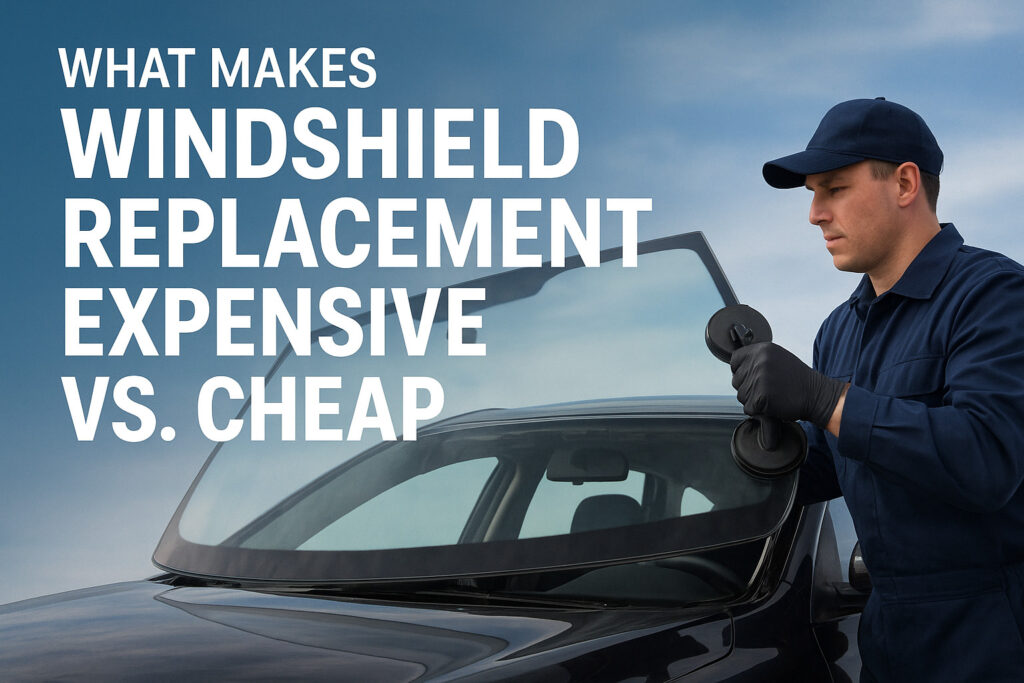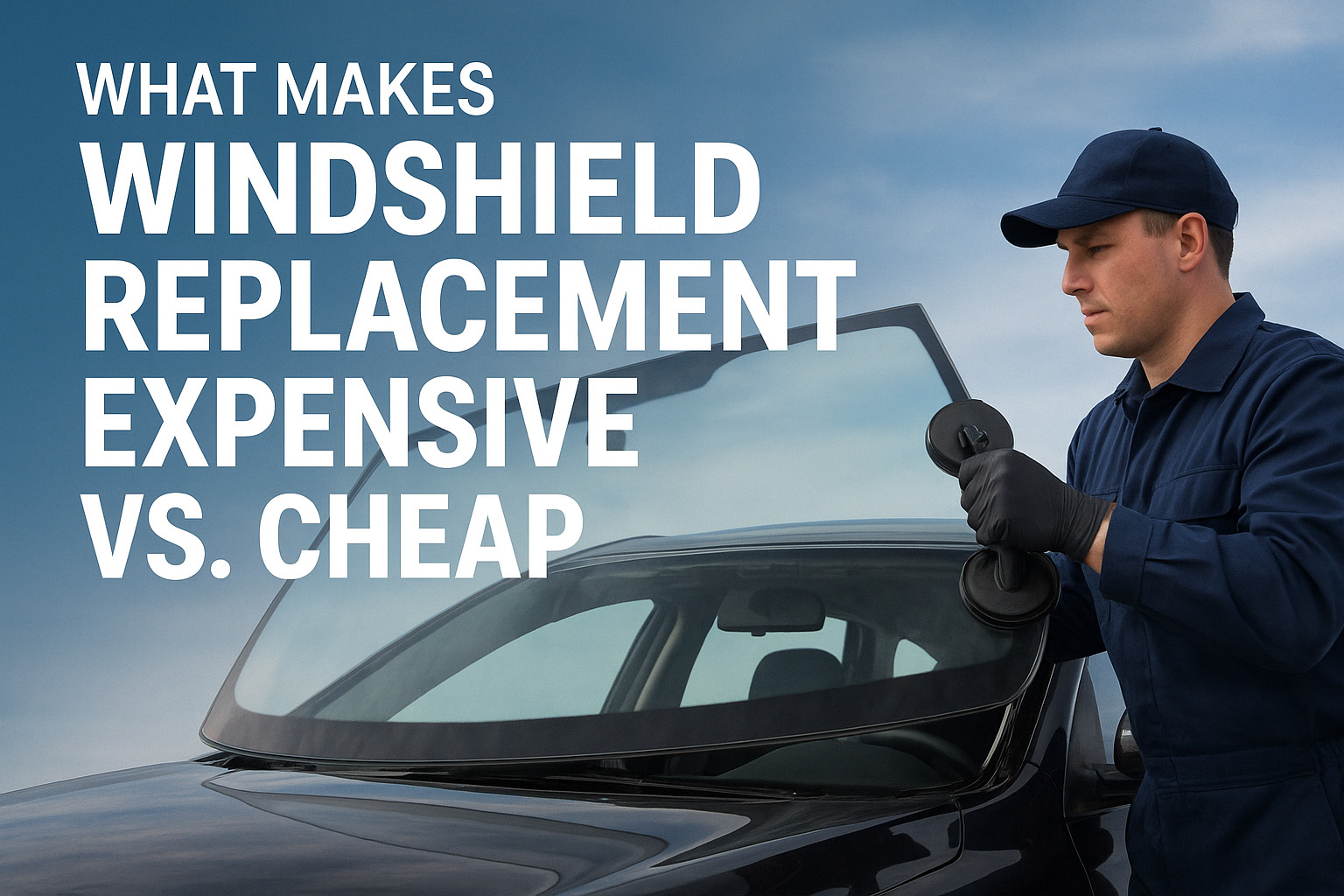Understanding Why Windshield Replacement Costs Vary So Much
If you’ve ever needed to replace a windshield, you may have been surprised by how much prices can differ. Some quotes are a few hundred dollars, while others can reach well over a thousand. What causes this huge range?
Windshield replacement costs depend on a combination of materials, technology, labor, and your specific vehicle’s design. Let’s break down the main factors that make windshield replacement expensive vs. cheap — and why paying less up front isn’t always the best deal in the long run.
1. Glass Quality and Type
The most basic difference between expensive and cheap windshield replacements comes down to the quality of the glass itself.
OEM (Original Equipment Manufacturer) glass is made to the same specifications as your vehicle’s factory windshield. It typically has the same thickness, tint, curvature, and noise-reduction features. OEM glass often includes the manufacturer’s logo and is designed to perfectly integrate with your car’s ADAS sensors.
Aftermarket glass, on the other hand, is produced by third-party companies. While it’s usually more affordable, quality can vary. Some aftermarket windshields may have slight distortions, different tints, or a less precise fit — which can affect visibility, sealing, and longevity over time.
In short: OEM glass costs more but ensures a perfect match. Aftermarket glass is cheaper but may not perform as well, especially on vehicles with advanced features.
2. ADAS and Sensor Technology
Modern vehicles often include Advanced Driver Assistance Systems (ADAS) such as lane departure warning, adaptive cruise control, or automatic emergency braking. Many of these systems rely on cameras and sensors mounted on or behind the windshield.
When a windshield with ADAS support is replaced, those sensors must be recalibrated to ensure safety systems function properly. This process can significantly increase the cost — sometimes adding $200 to $500 or more to the total bill.
Older vehicles without ADAS don’t require recalibration, which keeps replacement costs lower.
3. Vehicle Make and Model
Your vehicle’s make and model play a big role in determining windshield replacement cost.
- Luxury vehicles (like BMW, Mercedes-Benz, or Tesla) often have complex glass shapes, acoustic coatings, built-in heating elements, or heads-up displays that project information onto the glass. These features make the glass more expensive to manufacture and install.
- Standard vehicles (like Toyota, Honda, or Ford) usually have simpler glass designs, which are less costly to replace.
In short, the more advanced or unique your car is, the higher the windshield replacement cost tends to be.
4. Labor and Installation Expertise
Labor costs vary widely depending on the experience and certification of the technicians.
High-quality installations require trained professionals, proper adhesives, and precision tools. Cutting corners — such as rushing the job, using cheap adhesive, or failing to ensure a proper seal — can lead to leaks, wind noise, or even safety risks if the windshield detaches during a collision.
Trusted shops usually charge more because they invest in certified technicians, proper training, and the right materials to ensure a safe, lasting installation.
5. Mobile vs. In-Shop Service
Mobile windshield replacement (where a technician comes to you) adds convenience but may sometimes cost slightly more, especially if travel distance is significant or specialized tools are required.
In-shop service might offer lower pricing, but you’ll need to bring your vehicle in and wait during the repair. Some providers charge the same for both — it depends on the shop’s policies.
6. Insurance Coverage and Deductibles
Your auto insurance policy also affects how much you’ll pay out of pocket.
- If you have comprehensive coverage, your insurance may pay for windshield replacement after your deductible.
- Some states — like Arizona and Florida — require insurers to cover full glass replacement with no deductible.
- If you’re paying out of pocket, you have more freedom to shop around and compare pricing, but you’ll need to evaluate quality carefully.
The Importance of Proper Windshield Replacement
Your windshield is more than just glass, it’s a critical safety component of your vehicle. It supports the roof structure, ensures proper airbag deployment, and helps protect you during a collision.
Improper installation, cheap adhesive, or low-quality glass can all compromise your safety and lead to problems like leaks, distortion, or ADAS malfunction. That’s why choosing a trusted, certified shop is essential.
To make the process easier, use Glass.net’s free quote tool to compare up to three local windshield replacement shops near you. You can review pricing, services, and customer ratings, helping you find the best balance of cost, quality, and convenience.
Conclusion
Windshield replacement prices can vary widely, and understanding why helps you make smarter, safer choices.
- Expensive replacements usually involve OEM glass, advanced ADAS calibration, or luxury vehicle requirements.
- Cheaper replacements may use aftermarket glass, skip recalibration, or rely on less experienced installers — which can affect long-term safety and performance.
When it comes to your windshield, cutting corners can cost you more in the end. Always prioritize safety and quality, and use Glass.net’s free quote tool to find trusted, affordable, and professional windshield replacement shops near you.

To read more, visit blog.glass.net

